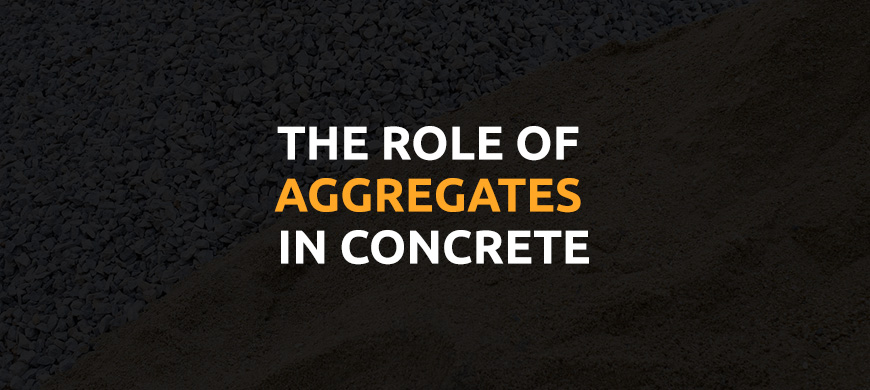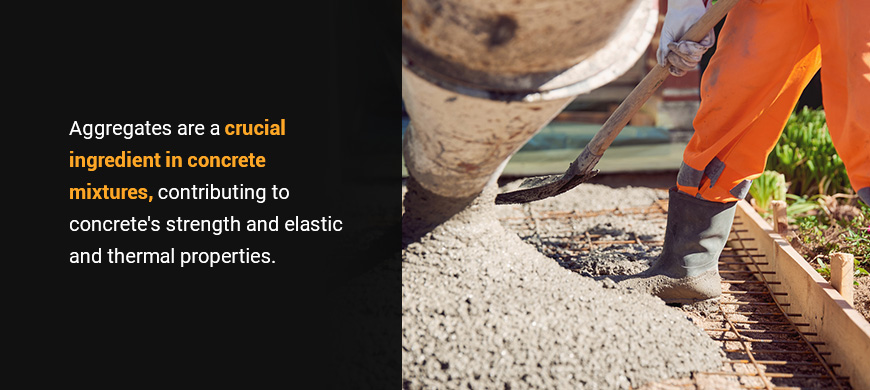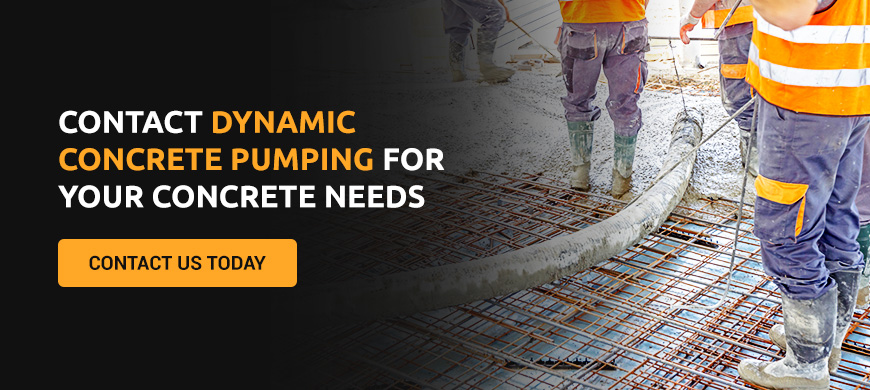
The Role of Aggregates in Concrete
Posted By:Dynamic Concrete Pumping , Date: Mar 22, 2023

In its simplest form, concrete is a combination of water, cement and aggregate. Combining aggregates with liquid cement allows it to mix evenly. Once the cement hardens, it binds to the aggregate, creating a durable and rigid material known as concrete.
Aggregate is one of the key ingredients that makes concrete durable enough for use in construction projects. Below, you’ll learn more about the role of aggregate in concrete, including the different types and portions you can use.
What Are Aggregates?
Aggregate in concrete is geological material such as sand, gravel or crushed rock. These aggregates mix with cement and water to help create the final product. Aggregate is often added to concrete in specific construction projects, such as parking lots, highways, railways, runways and walkways.
Aggregates must use robust, clean and hard particles without chemicals or coatings that could deteriorate the concrete. The characteristics of the aggregate you choose, including its size, weight and moisture content, can affect the performance and character of your final product.
An aggregate’s particle sizes influence the concrete’s structure and quality. One role of coarse aggregate in concrete is to reduce production costs by reducing the amount of cement you need. Cement tends to be more expensive than aggregates and you won’t need as much to create the final product. However, choosing the maximum particle size leaves more void space between particles, leaving the concrete weaker and more vulnerable to damage. Ideally, you’ll want to select an aggregate with various particle sizes to make the strongest, most durable product.
Aggregate proportions are typically about 60%-75% of the total mixture. Concrete often uses the following proportions:
- 10%-15% cement
- 60%-80% aggregates
- 20% water
- Remaining percentage air
Since aggregates usually make up a significant portion of concrete mixtures, selecting them for durability is vital. Using proper control measures will help you produce strong, resilient, workable concrete with a quality finish. During the design phase of construction projects, you’ll analyze aggregates’ size, type and material properties to ensure they meet the requirements for each project stage.

How Are Aggregates Used in Concrete?
Aggregates are a crucial ingredient in concrete mixtures, contributing to concrete’s strength and elastic and thermal properties. Aggregates also help with concrete’s dimension and volume stability while controlling shrinkage and preventing cracking. You’ll want to select your aggregates based on the workability, strength, durability and finish you need for your project.
Gradation specifically looks at the available space within the concrete, determining how dense or sparse the aggregate is. Aggregates receive one of three typical grades:
- Well-graded: Well-graded aggregate is at the top of the grading tiers. These aggregates are tightly packed and contain various particle sizes. Its different particle sizes mean well-graded aggregate can take up the available space within the concrete, making it stronger and more resilient. While this grade is the strongest, it may have a less appealing appearance based on your chosen particles.
- Poorly graded: This grade shows minimal variation in particle size within the concrete. Since most of the aggregate is the same size, it typically can’t take up all the space in the concrete, leaving a void that requires a significant amount of concrete to fill. As a result, poorly graded concrete is weaker and more vulnerable to damage.
- Gap graded: This grade contains a combination or small and large particles. While gap-graded aggregate is tightly packed, it doesn’t include medium-sized aggregates. The significant difference in particle size doesn’t provide the same uniformity as well-graded aggregate concrete.
What Type of Aggregate Is Used in Concrete?
Understanding the different types of aggregates ensures you can utilize their maximum potential during construction projects. For example, crushed stone aggregates are essential for sand traps on golf courses, roads and buildings, while gravel aggregate help with water drainage and erosion control.
Aggregate materials are found in underground sediment, mines, quarries or deposits. Some types of aggregates used in concrete include:
- Sand: Sand aggregate is found in nature, typically at deposits, through mining or at repositories. Sand is a fine material made from stone and mineral particles with a composition that varies depending on its location of origin. You can also choose sand from specific locations, such as rivers, pits and oceans, to find the right size. Sand aggregate is useful for manufacturing concrete or developing roadways. You can find varied sand particle sizes to meet your needs, including fine sand, coarse sand and grains in between these sizes.
- Gravel: Gravel often comes from moisture and erosion. You can choose from several different types, including ¾ inch, 1½ inch, subbase, seal and hydraulic base. Gravel is ideal for various construction projects, including roadways, concrete manufacturing and aesthetic or decorative projects.
- Crushed rock: This type of aggregate begins by extracting rocks from mines, quarries or deposits. Once extracted, they’re crushed until they reach the desired texture and size. You can use all types of rocks to make crushed rock aggregates, which you can use in various construction projects, such as roads, walkways and parking lots.
- Recycled concrete: This aggregate utilizes concrete from demolished construction projects. You can break, cut or grind this concrete until it reaches the desired size. Recycled concrete typically serves as a base for other construction materials. It’s more compact, creating a firm surface that is easy to build on top of.
Choosing the right aggregate type depends on your construction project and what gradation you need from your concrete. If you’re looking for various particle sizes, you may choose a combination of aggregates to help create a compact and durable product. You can also choose from a single aggregate like sand if you don’t need a strong gradation. Mixing different types, such as crushed rock and sand, lets you create gap-graded aggregates.
Contact Dynamic Concrete Pumping for Your Concrete Needs
Aggregate helps make your final concrete product stronger and more durable, but it’s essential to use the correct tools to complete your project. Dynamic Concrete Pumping has over 40 years of experience providing services to contractors who need concrete placing and pumping. As the industry evolves, we’re updating our equipment to ensure our clients have access to cutting-edge technology that can revolutionize their projects.
We offer revolutionary concrete pumping services with an impressive fleet of concrete pumping equipment, including boom pumps, line pumps and separate placement booms. We also use an eco-friendly alternative to hydraulic fuel, helping you achieve sustainability goals. Contact us today to learn more about how we can help you achieve your concrete project goals.


